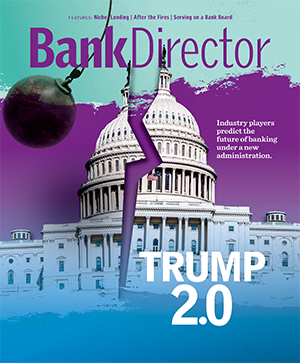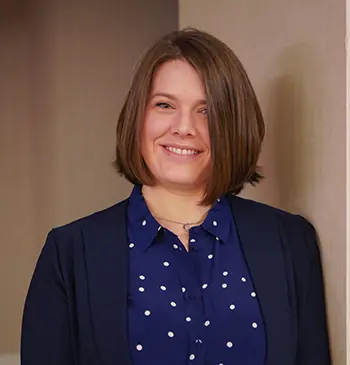Laura Alix is the Director of Research at Bank Director, where she collaborates on strategic research for bank directors and senior executives, including Bank Director’s annual surveys. She also writes for BankDirector.com and edits online video content. Laura is particularly interested in workforce management and retention strategies, environmental, social and governance issues, and fraud. She has previously covered national and regional banks for American Banker and community banks and credit unions for Banker & Tradesman. Based in Boston, she has a bachelor’s degree from the University of Connecticut and a master’s degree from CUNY Brooklyn College.

Stablecoins: Friend or Foe to the Banking Industry?
The second Trump administration came out swinging in favor of crypto and stablecoins. But what could that mean for the banking industry?
President Donald Trump and some lawmakers have pushed for a friendlier regulatory environment for cryptocurrencies and stablecoins, but that doesn’t mean bankers are all warming up to digital assets.
Upon taking office, the president appointed a “crypto czar” and signed an executive order supporting the “responsible growth and use of digital assets, blockchain technology, and related technologies …”
In early February, lawmakers introduced draft legislation that would establish a regulatory framework for payment stablecoins. Among other things, the proposed bills outline procedures for institutions looking to issue stablecoins and they set up reserve requirements and regulatory standards for stablecoin issuers.
But what is a stablecoin anyway? And what is its potential impact on the banking industry? Put simply, a stablecoin is a type of cryptocurrency that’s pegged to another asset, perhaps gold or a fiat currency, such as the U.S. dollar, and is therefore intended to maintain a more stable value over time. Contrast that with cryptocurrency more broadly, which can fluctuate wildly in value relative to the dollar.
Stablecoins originated roughly a decade ago as a way for people interested in trading Bitcoin to hold their dollars in the crypto universe, says Michael Perito, head of bank strategy for Travillian Group. They could be assured the value of those dollars would remain stable, rather than trying to convert those dollars back into fiat currency.
“It’s meant to mimic a digital dollar, and the way they make sure that the value of it always stays a dollar is by having the Treasury reserve dollar for dollar behind it,” he says.
Instantaneous payments, particularly cross-border payments, are a common use case for stablecoins today, and here they have some distinct advantages over traditional banking services, says Marissa Scicchitano, a principal with Wolf & Co.
“Right now, you have to go to a bank, ask them to create a wire transfer, and it takes three business days. Whereas with stablecoins, you can log into your phone and send the funds wherever you want them to go,” she says. Stablecoin payments settle instantly over the blockchain, but banks may implement manual or automatic checks, like a know-your-customer verification, to happen before the payment is processed, Scicchitano added.
Scott Goodwin, also a partner with Wolf & Co., likens stablecoin almost to a money market account that an individual could use to transact. Stablecoins generally don’t offer any yield to purchasers, but they could depending on the particular issuer.
What broader acceptance and use of stablecoins means for community banks, however, may be a little bit less clear at the moment. Whether a bank sees stablecoin as a potential opportunity or as a competitive threat may depend on the particular organization’s strategy. For the moment, it seems much of the industry leans towards the latter view.
A recent survey by the reciprocal deposit network Intrafi found that bank executives generally see crypto and stablecoin as a threat to their industry. Sixty-two percent say they’re concerned crypto will have an outsized influence on the Trump administration’s policies governing the financial sector, and 67% are concerned the growth in stablecoins could encourage consumers to pull their money out of banks.
A 2023 paper by Mark Flannery of the University of Florida suggests that increased issuance of stablecoins could draw deposits away from the banking systems and reduce their lending capacity. On the other hand, if stablecoin reserves are held primarily in bank deposits, that leaves banks’ lending capacities largely untouched.
Stablecoins could be an opportunity for some banks.
“There has been a fairly long period of time where the various regulatory bodies touching banks essentially precluded them from participating in digital assets,” Goodwin says. “What that did was force that activity out of our best, most trusted and most highly regulated institutions and made that business go elsewhere.”
Some use cases may appeal to certain banks, particularly if they’re passing the torch to the next generation of leadership or looking to be an early mover.
“If a bank asked me to make a business case for this, I would say, ‘How much better would your business be if you could take in deposits but never have to pay those people interest on those deposits?’” Goodwin says. “The economics of operating a stablecoin are pretty compelling.”
Banks may want to approach stablecoins with a healthy dose of skepticism. Bank directors should at least understand what stablecoins are and the technology they operate on. Some would argue there are other potential use cases for distributed ledger technology in the banking world, Perito says.
Rather than just chase the newest shiny object, bank directors might take the current moment to consider whether there’s a place for stablecoins within their own current or future strategy. Trump has a single term and therefore, a limited window of time to push through legislation on crypto.
“The next year or two really should be a heavy educational period,” Perito says. “Then after the midterm [elections], if it looks like there’s some legs to this thing, you want to at least not be starting to understand it.”


